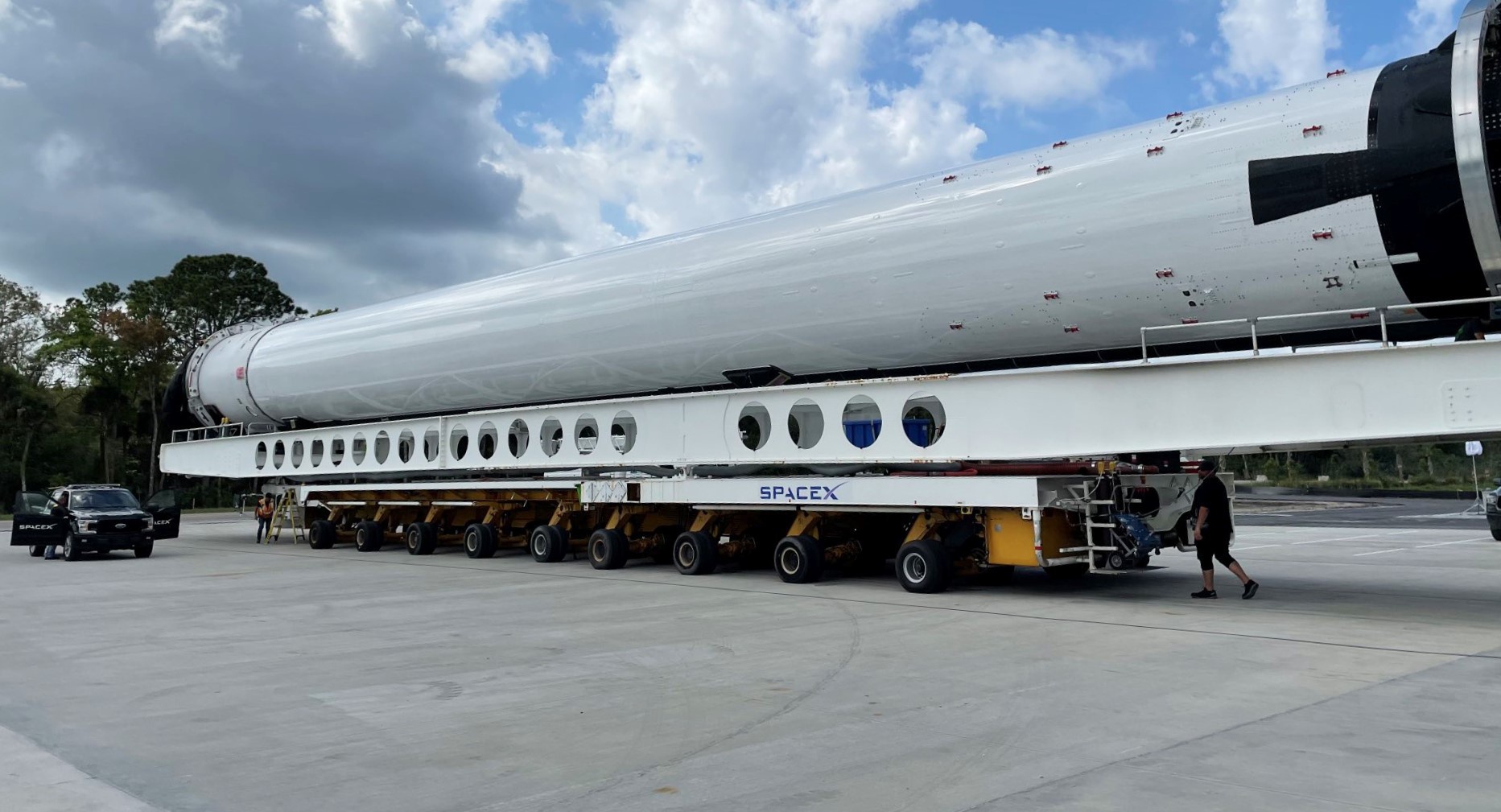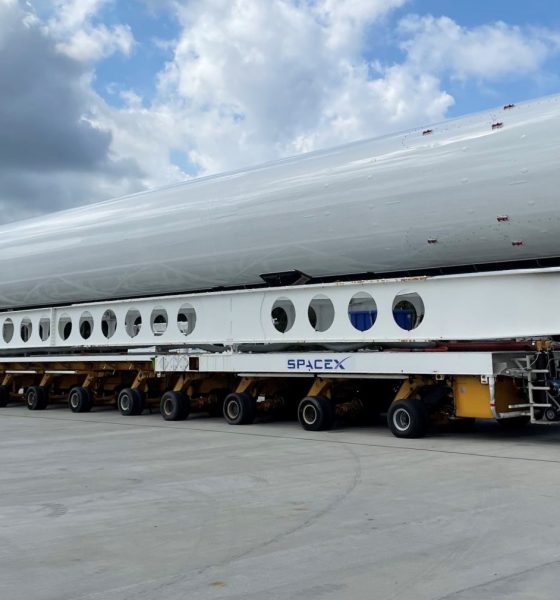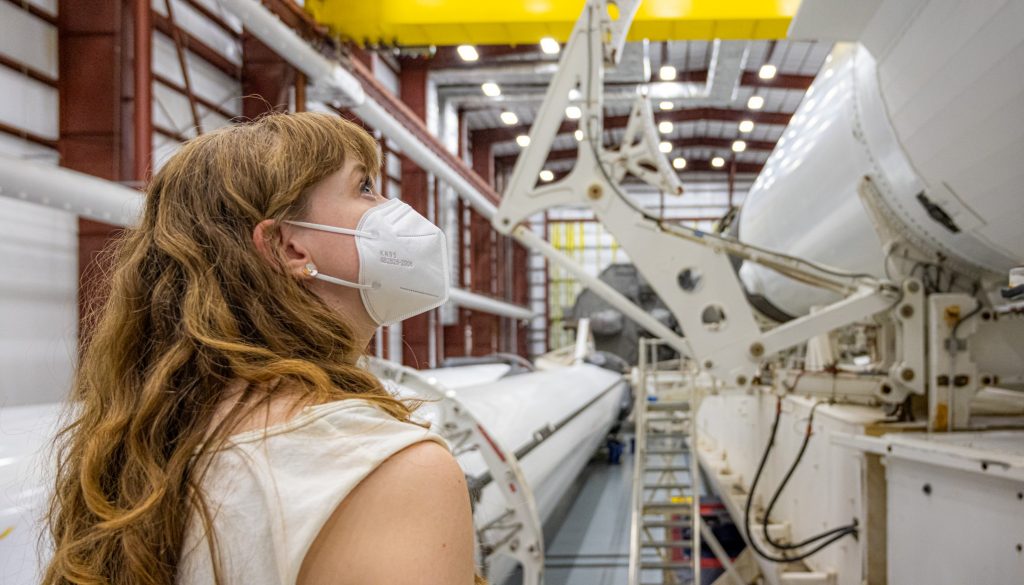

News
SpaceX Falcon Heavy booster spotted at Kennedy Space Center
SpaceX has been spotted transporting a Falcon Heavy booster through NASA’s Kennedy Space Center (KSC) facilities, offering a slight glimpse behind the scenes amid a seemingly unending series of launch delays for the most powerful operational rocket in the world.
Continuing a recent surge of Falcon Heavy booster appearances at or around SpaceX facilities, the latest instance saw the company transporting new, unflown Falcon Heavy center core south through KSC to its HangarX rocket storage and processing facilities. While it does not appear that this particular Falcon Heavy center core is the same core believed to be assigned to the rocket’s next launch, its movement is still significant.
First, it’s not entirely clear where the Falcon Heavy center core came from. SpaceX maintains several fragmented processing and storage facilities in hangars strewn throughout the Cape Canaveral Space Force Station (CCSFS), though SpaceX’s new HangarX facility – located within KSC ground – was presumably meant to organize booster and fairing storage, outfitting, and refurbishment under one roof.
Regardless, the new Falcon Heavy center core moved to HangarX on March 9th, 2022 was missing at least a few essential parts, suggesting that it could merely be headed there to be fully outfitted for an upcoming launch. However, it could also have been moved to HangarX for longer-term storage after waiting too long at a satellite storage facility. Due to seemingly unrelenting delays impacting at least three of several Falcon Heavy launches planned in 2022, SpaceX has been stuck shuffling more and more Falcon Heavy cores over the last six or so months.


As of September 2021, all three new Falcon Heavy cores meant to support USSF-44 – set to be the rocket’s first launch in more than two years – were already inside the integration hangar at Pad 39A, the only launch site able to support Falcon Heavy. Originally meant to launch in late 2020, both USSF-44 and USSF-52 have been more or less indefinitely delayed ever since. In September, USSF-44 – one or several geostationary US military satellites – was expected to launch as early as October 2021. Soon after, the launch was delayed to “early 2022.” As of March 2022, the US military now refuses to offer even a vague public estimate for the mission’s latest launch target.
Combined with a series of either two or three Dragon launches – all of which need Pad 39A – planned as early as late March, mid-April, and early May, it’s now all but guaranteed that Falcon Heavy will have to wait until May or June 2022 for its first launch since June 2019 – a staggering three-year gap. Due to those delays, SpaceX is currently juggling an unprecedented fleet of six (soon to be seven) unflown, ready-for-flight Falcon Heavy boosters on top of another dozen flight-proven Falcon 9 and Heavy boosters.
On top of the military’s USSF-44 and USSF-52 missions, both of which are now years behind schedule, satellite communications provider ViaSat also recently announced the latest in a long line of ViaSat-3 launch delays, pushing its Falcon Heavy launch from this spring to no earlier than “late summer” – i.e. late Q3 2022. Ironically, of Falcon Heavy’s near-term missions, only NASA’s Psyche spacecraft – designed to orbit and explore an exotic asteroid tens to hundreds of millions of miles from Earth – has survived the last year or two without a major launch delay. It remains on track to launch in August 2022.
In fact, given that there is apparently so much uncertainty surrounding USSF-44 and USSF-52 that the US military is no longer willing to offer any public schedule estimate, it’s starting to look likely that Psyche – barring its own delays – could launch before USSF-44, USSF-52, and ViaSat-3. If that’s the case, SpaceX has almost half a year to prepare for the launch and it would only make sense to move all Falcon Heavy cores to longer-term storage until schedule confidence improves.
Unfortunately, that means that until there are signs of tangible preparations or actual military payloads arriving at Cape Canaveral, it’s very likely that SpaceX will have to wait until August 2022 at the earliest for Falcon Heavy’s first launch in more than three years.

News
Tesla FSD fleet is nearing 7 billion total miles, including 2.5 billion city miles
As can be seen on Tesla’s official FSD webpage, vehicles equipped with the system have now navigated over 6.99 billion miles.

Tesla’s Full Self-Driving (Supervised) fleet is closing in on almost 7 billion total miles driven, as per data posted by the company on its official FSD webpage.
These figures hint at the massive scale of data fueling Tesla’s rapid FSD improvements, which have been quite notable as of late.
FSD mileage milestones
As can be seen on Tesla’s official FSD webpage, vehicles equipped with the system have now navigated over 6.99 billion miles. Tesla owner and avid FSD tester Whole Mars Catalog also shared a screenshot indicating that from the nearly 7 billion miles traveled by the FSD fleet, more than 2.5 billion miles were driven inside cities.
City miles are particularly valuable for complex urban scenarios like unprotected turns, pedestrian interactions, and traffic lights. This is also the difference-maker for FSD, as only complex solutions, such as Waymo’s self-driving taxis, operate similarly on inner-city streets. And even then, incidents such as the San Francisco blackouts have proven challenging for sensor-rich vehicles like Waymos.
Tesla’s data edge
Tesla has a number of advantages in the autonomous vehicle sector, one of which is the size of its fleet and the number of vehicles training FSD on real-world roads. Tesla’s nearly 7 billion FSD miles then allow the company to roll out updates that make its vehicles behave like they are being driven by experienced drivers, even if they are operating on their own.
So notable are Tesla’s improvements to FSD that NVIDIA Director of Robotics Jim Fan, after experiencing FSD v14, noted that the system is the first AI that passes what he described as a “Physical Turing Test.”
“Despite knowing exactly how robot learning works, I still find it magical watching the steering wheel turn by itself. First it feels surreal, next it becomes routine. Then, like the smartphone, taking it away actively hurts. This is how humanity gets rewired and glued to god-like technologies,” Fan wrote in a post on X.
News
Tesla starts showing how FSD will change lives in Europe
Local officials tested the system on narrow country roads and were impressed by FSD’s smooth, human-like driving, with some calling the service a game-changer for everyday life in areas that are far from urban centers.

Tesla has launched Europe’s first public shuttle service using Full Self-Driving (Supervised) in the rural Eifelkreis Bitburg-Prüm region of Germany, demonstrating how the technology can restore independence and mobility for people who struggle with limited transport options.
Local officials tested the system on narrow country roads and were impressed by FSD’s smooth, human-like driving, with some calling the service a game-changer for everyday life in areas that are far from urban centers.
Officials see real impact on rural residents
Arzfeld Mayor Johannes Kuhl and District Administrator Andreas Kruppert personally tested the Tesla shuttle service. This allowed them to see just how well FSD navigated winding lanes and rural roads confidently. Kruppert said, “Autonomous driving sounds like science fiction to many, but we simply see here that it works totally well in rural regions too.” Kuhl, for his part, also noted that FSD “feels like a very experienced driver.”
The pilot complements the area’s “Citizen Bus” program, which provides on-demand rides for elderly residents who can no longer drive themselves. Tesla Europe shared a video of a demonstration of the service, highlighting how FSD gives people their freedom back, even in places where public transport is not as prevalent.
What the Ministry for Economic Affairs and Transport says
Rhineland-Palatinate’s Minister Daniela Schmitt supported the project, praising the collaboration that made this “first of its kind in Europe” possible. As per the ministry, the rural rollout for the service shows FSD’s potential beyond major cities, and it delivers tangible benefits like grocery runs, doctor visits, and social connections for isolated residents.
“Reliable and flexible mobility is especially vital in rural areas. With the launch of a shuttle service using self-driving vehicles (FSD supervised) by Tesla in the Eifelkreis Bitburg-Prüm, an innovative pilot project is now getting underway that complements local community bus services. It is the first project of its kind in Europe.
“The result is a real gain for rural mobility: greater accessibility, more flexibility and tangible benefits for everyday life. A strong signal for innovation, cooperation and future-oriented mobility beyond urban centers,” the ministry wrote in a LinkedIn post.
News
Tesla China quietly posts Robotaxi-related job listing
Tesla China is currently seeking a Low Voltage Electrical Engineer to work on circuit board design for the company’s autonomous vehicles.

Tesla has posted a new job listing in Shanghai explicitly tied to its Robotaxi program, fueling speculation that the company is preparing to launch its dedicated autonomous ride-hailing service in China.
As noted in the listing, Tesla China is currently seeking a Low Voltage Electrical Engineer to work on circuit board design for the company’s autonomous vehicles.
Robotaxi-specific role
The listing, which was shared on social media platform X by industry watcher @tslaming, suggested that Tesla China is looking to fill the role urgently. The job listing itself specifically mentions that the person hired for the role will be working on the Low Voltage Hardware team, which would design the circuit boards that would serve as the nervous system of the Robotaxi.
Key tasks for the role, as indicated in the job listing, include collaboration with PCB layout, firmware, mechanical, program management, and validation teams, among other responsibilities. The role is based in Shanghai.
China Robotaxi launch
China represents a massive potential market for robotaxis, with its dense urban centers and supportive policies in select cities. Tesla has limited permission to roll out FSD in the country, though despite this, its vehicles have been hailed as among the best in the market when it comes to autonomous features. So far, at least, it appears that China supports Tesla’s FSD and Robotaxi rollout.
This was hinted at in November, when Tesla brought the Cybercab to the 8th China International Import Expo (CIIE) in Shanghai, marking the first time that the autonomous two-seater was brought to the Asia-Pacific region. The vehicle, despite not having a release date in China, received a significant amount of interest among the event’s attendees.








